1.7: Rock and Roll
- Page ID
- 168902
\( \newcommand{\vecs}[1]{\overset { \scriptstyle \rightharpoonup} {\mathbf{#1}} } \)
\( \newcommand{\vecd}[1]{\overset{-\!-\!\rightharpoonup}{\vphantom{a}\smash {#1}}} \)
\( \newcommand{\dsum}{\displaystyle\sum\limits} \)
\( \newcommand{\dint}{\displaystyle\int\limits} \)
\( \newcommand{\dlim}{\displaystyle\lim\limits} \)
\( \newcommand{\id}{\mathrm{id}}\) \( \newcommand{\Span}{\mathrm{span}}\)
( \newcommand{\kernel}{\mathrm{null}\,}\) \( \newcommand{\range}{\mathrm{range}\,}\)
\( \newcommand{\RealPart}{\mathrm{Re}}\) \( \newcommand{\ImaginaryPart}{\mathrm{Im}}\)
\( \newcommand{\Argument}{\mathrm{Arg}}\) \( \newcommand{\norm}[1]{\| #1 \|}\)
\( \newcommand{\inner}[2]{\langle #1, #2 \rangle}\)
\( \newcommand{\Span}{\mathrm{span}}\)
\( \newcommand{\id}{\mathrm{id}}\)
\( \newcommand{\Span}{\mathrm{span}}\)
\( \newcommand{\kernel}{\mathrm{null}\,}\)
\( \newcommand{\range}{\mathrm{range}\,}\)
\( \newcommand{\RealPart}{\mathrm{Re}}\)
\( \newcommand{\ImaginaryPart}{\mathrm{Im}}\)
\( \newcommand{\Argument}{\mathrm{Arg}}\)
\( \newcommand{\norm}[1]{\| #1 \|}\)
\( \newcommand{\inner}[2]{\langle #1, #2 \rangle}\)
\( \newcommand{\Span}{\mathrm{span}}\) \( \newcommand{\AA}{\unicode[.8,0]{x212B}}\)
\( \newcommand{\vectorA}[1]{\vec{#1}} % arrow\)
\( \newcommand{\vectorAt}[1]{\vec{\text{#1}}} % arrow\)
\( \newcommand{\vectorB}[1]{\overset { \scriptstyle \rightharpoonup} {\mathbf{#1}} } \)
\( \newcommand{\vectorC}[1]{\textbf{#1}} \)
\( \newcommand{\vectorD}[1]{\overrightarrow{#1}} \)
\( \newcommand{\vectorDt}[1]{\overrightarrow{\text{#1}}} \)
\( \newcommand{\vectE}[1]{\overset{-\!-\!\rightharpoonup}{\vphantom{a}\smash{\mathbf {#1}}}} \)
\( \newcommand{\vecs}[1]{\overset { \scriptstyle \rightharpoonup} {\mathbf{#1}} } \)
\( \newcommand{\vecd}[1]{\overset{-\!-\!\rightharpoonup}{\vphantom{a}\smash {#1}}} \)
\(\newcommand{\avec}{\mathbf a}\) \(\newcommand{\bvec}{\mathbf b}\) \(\newcommand{\cvec}{\mathbf c}\) \(\newcommand{\dvec}{\mathbf d}\) \(\newcommand{\dtil}{\widetilde{\mathbf d}}\) \(\newcommand{\evec}{\mathbf e}\) \(\newcommand{\fvec}{\mathbf f}\) \(\newcommand{\nvec}{\mathbf n}\) \(\newcommand{\pvec}{\mathbf p}\) \(\newcommand{\qvec}{\mathbf q}\) \(\newcommand{\svec}{\mathbf s}\) \(\newcommand{\tvec}{\mathbf t}\) \(\newcommand{\uvec}{\mathbf u}\) \(\newcommand{\vvec}{\mathbf v}\) \(\newcommand{\wvec}{\mathbf w}\) \(\newcommand{\xvec}{\mathbf x}\) \(\newcommand{\yvec}{\mathbf y}\) \(\newcommand{\zvec}{\mathbf z}\) \(\newcommand{\rvec}{\mathbf r}\) \(\newcommand{\mvec}{\mathbf m}\) \(\newcommand{\zerovec}{\mathbf 0}\) \(\newcommand{\onevec}{\mathbf 1}\) \(\newcommand{\real}{\mathbb R}\) \(\newcommand{\twovec}[2]{\left[\begin{array}{r}#1 \\ #2 \end{array}\right]}\) \(\newcommand{\ctwovec}[2]{\left[\begin{array}{c}#1 \\ #2 \end{array}\right]}\) \(\newcommand{\threevec}[3]{\left[\begin{array}{r}#1 \\ #2 \\ #3 \end{array}\right]}\) \(\newcommand{\cthreevec}[3]{\left[\begin{array}{c}#1 \\ #2 \\ #3 \end{array}\right]}\) \(\newcommand{\fourvec}[4]{\left[\begin{array}{r}#1 \\ #2 \\ #3 \\ #4 \end{array}\right]}\) \(\newcommand{\cfourvec}[4]{\left[\begin{array}{c}#1 \\ #2 \\ #3 \\ #4 \end{array}\right]}\) \(\newcommand{\fivevec}[5]{\left[\begin{array}{r}#1 \\ #2 \\ #3 \\ #4 \\ #5 \\ \end{array}\right]}\) \(\newcommand{\cfivevec}[5]{\left[\begin{array}{c}#1 \\ #2 \\ #3 \\ #4 \\ #5 \\ \end{array}\right]}\) \(\newcommand{\mattwo}[4]{\left[\begin{array}{rr}#1 \amp #2 \\ #3 \amp #4 \\ \end{array}\right]}\) \(\newcommand{\laspan}[1]{\text{Span}\{#1\}}\) \(\newcommand{\bcal}{\cal B}\) \(\newcommand{\ccal}{\cal C}\) \(\newcommand{\scal}{\cal S}\) \(\newcommand{\wcal}{\cal W}\) \(\newcommand{\ecal}{\cal E}\) \(\newcommand{\coords}[2]{\left\{#1\right\}_{#2}}\) \(\newcommand{\gray}[1]{\color{gray}{#1}}\) \(\newcommand{\lgray}[1]{\color{lightgray}{#1}}\) \(\newcommand{\rank}{\operatorname{rank}}\) \(\newcommand{\row}{\text{Row}}\) \(\newcommand{\col}{\text{Col}}\) \(\renewcommand{\row}{\text{Row}}\) \(\newcommand{\nul}{\text{Nul}}\) \(\newcommand{\var}{\text{Var}}\) \(\newcommand{\corr}{\text{corr}}\) \(\newcommand{\len}[1]{\left|#1\right|}\) \(\newcommand{\bbar}{\overline{\bvec}}\) \(\newcommand{\bhat}{\widehat{\bvec}}\) \(\newcommand{\bperp}{\bvec^\perp}\) \(\newcommand{\xhat}{\widehat{\xvec}}\) \(\newcommand{\vhat}{\widehat{\vvec}}\) \(\newcommand{\uhat}{\widehat{\uvec}}\) \(\newcommand{\what}{\widehat{\wvec}}\) \(\newcommand{\Sighat}{\widehat{\Sigma}}\) \(\newcommand{\lt}{<}\) \(\newcommand{\gt}{>}\) \(\newcommand{\amp}{&}\) \(\definecolor{fillinmathshade}{gray}{0.9}\)Rock & Roll
The term “Rock & Roll” comes primarily from sources in Rhythm & Blues songs. The words “rockin” and “rollin” both appear in song titles and song lyrics (think “Good Rockin’ Tonight” by Roy Brown). The term was popularized in the mid-1950s, being used to identify Rhythm and Blues by disc jockey Alan Freed who used it incessantly on his radio programs (he even attempted to copyright the term), and it quickly found it’s way into the vernacular of popular American culture. Indeed, many rock historians consider both the Blues and Rhythm & Blues of the 1940’s to be inextricably linked, and often times nearly identical in form and style to Rock & Roll.
It is difficult to decide when Rock & Roll becomes a distinct style from Blues and Rhythm & Blues. There are, however, a few characteristics that differ between the two. One difference is the fact that Rock didn’t use horns as often as R&B; rather, Rock would often feature the electric guitar, the primary instrument in Urban Blues (and often featured in Country music). Also, many white Rock musicians brought a background in Country music into Rock and Roll. One non-musical difference is that R&B musicians were primarily black, and when white musicians began playing the same music the term Rock & Roll was introduced. To many historians, this seems a case where the music was rebranded to distinguish it from a thoroughly African-American art form in order to make it more acceptable to a 1950s mainstream white culture accustomed to segregation.
Big Joe Turner
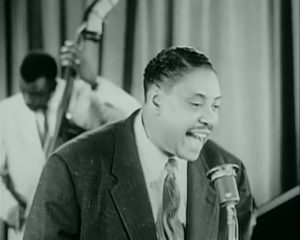
Joe Turner – (1911–1985) Was a blues vocalist that pioneered early rock and roll. He began singing jazz in the 1920’s, and became an accomplished singer of jazz-styled blues and jump blues. He is often referred to as a “ blues shouter” because in performance he would often shout to make his voice match the honking sound of the saxophones.
Turner wrote “Shake, Rattle and Roll”, recording it before Bill Haley recorded the much more famous version. Turner’s recording contains alleged sexual references which prevented it from receiving much radio play, while Haley’s recording used a “cleaned up” version of the lyrics in which these references were subdued. This “Sanitizing” of lyrics became a common practice for white recording artists covering songs by black Rhythm and Blues artists and ultimately led to greater record sales in the relatively conservative social climate of 1950s America, though as time has passed many listeners began to seek and ultimately preferred the songs as they were originally written. Haley’s version was also faster with fewer jazz characteristics such as improvisation. Haley’s version was No. 1 on the Pop charts while Turner’s was No. 1 on the Rhythm and Blues charts. To a certain extent these two different charts provide a reflection of the listening habits of white (pop) versus black (R&B) listeners, though there was certainly a good deal of crossover.
Examine the first two vocal sections of the song (the example in Ch. 7 Listening Examples has altered lyrics) and try to identify the song form. Based on what we know of common blues song forms, this lyrical scheme should be familiar.
Well get out of that bed, wash your face and hands
Get out of that bed, wash your face and hands
Well get in that kitchen, make some noise with the pots and pans
I believe it to my soul you’re the devil in nylon hose
I believe it to my soul you’re the devil in nylon hose
For the harder I work the faster my money goes
Bill Haley
Bill Haley – (1925–1981) Started out as a country singer/guitarist who played western swing, became one of the first rock stylists.
In the late 1940’s, Haley worked as a disc jockey where he was no doubt exposed to Blues and Rhythm and Blues. He formed a western swing group to play on his program. In 1951, Haley covered “Rocket 88”, a blues song written by Jackie Brenston. Though the record did not sell well, Haley saw that white teens very much enjoyed Rhythm and Blues. The next year, Haley dropped his country image, changed his group’s name to the Comets (as in Haley’s Comet), and began recording Blues and Rhythm and Blues songs.
In 1954 the Comets signed to Decca records and recorded two blues covers that became particularly successful: “(We’re Gonna) Rock Around the Clock” written by the songwriting team of Freedman/Myers, and Big Joe Turner’s “Shake, Rattle and Roll”. The latter proved an early success for Haley who was showcasing rhythm and blues to a new audience. The song reached #7 on the pop charts and eventually sold over a million copies. “Rock Around the Clock” initially did not sell as well until the following year when it was featured in a film called Blackboard Jungle. After the film was released the song reached No. 1 for 8 weeks on the pop charts, proving that the combination of “clean” lyrics and high-energy blues was a formula for success. Notice when listening that the song, like so many rhythm and blues songs, is a joyful, fast, happy version of the blues, ie. it is in a modified 12 Bar Blues Form that uses 3 different lines of text rather than the standard AAB lyrical scheme.
Sam Phillips and Sun Record
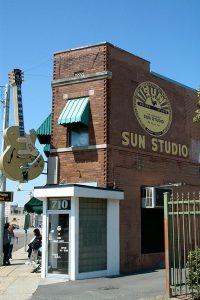
Sam Phillips – (1923–2003) worked as a disc jockey in Alabama while a teenager. In 1944, moved to Memphis, Tennessee at the age of 21 and started the Memphis Recording Service. Phillips was a blues fan and mostly recorded southern African American musicians. He recorded Jackie Brenston’s “Rocket 88” (the same covered by Haley) as well as blues musicians like Howlin’ Wolf. In 1951, Phillips formed the Sun Record Company in order to release his recordings himself. At Sun, Phillips was an innovative producer, developing unique studio effects such as “slapback echo” that characterized many of the records released by Sun. In addition to his production talents, Phillips was responsible for starting the careers of important early Rock pioneers Elvis Presley, Jerry Lee Lewis, and Carl Perkins.
Phillips was aware of the growing interest of young white Americans in Rhythm and Blues, but also to the fact that the tendency was for them to buy recordings by white musicians. He decided a white performer who could capture the style of African American singers would be a success. He also felt the need to adapt the lyrics to more conservative tastes because they often contained sexual references which parents would disapprove of. In 1954, he found a young singer he thought could fill this role successfully whose name was Elvis Presley.
Listening Examples 7.1
Big Joe Turner:“Shake Rattle and Roll” with alternate lyrics, likely changed because of TV censors.
Bill Haley and the Comets: Bill Haley performing “Rock Around the Clock” live on the Ed Sullivan show on August 7th, 1955. Although he appeared on the Milton Berle Show earlier, his appearance on Ed Sullivan provided an equally important nudge into popular culture following the success of Blackboard Jungle. Elvis Presley would follow suit in 1956, appearing on both Berle’s and Sullivan’s programs. Here is the studio version of “Rock Around the Clock”.
Jackie Brenston:
Elvis Presley: Early Years and Rockabilly
Elvis Presley – (1935–1977) Began recording with Sam Phillips in 1954 and introduced a new style known as Rockabilly (Rock+Hillbilly). Elvis was a multi-talented star that brought Rock & Roll to millions of Americans. While Elvis only co-wrote a a handful of songs and wasn’t known for songwriting, his artistry lied in the performing arts, with his singing, his dancing, and even his acting gaining him a legendary stature in the music world.
Elvis’ backing band included guitarist Scotty Moore, who played with a country style (steady beat) and sliding of strings giving the effect of a pedal steel (also characteristic of country music). Moore also had a background with jazz music, and the complex lead lines are more reminiscent of Chet Atkins (country-jazz-classical) or Charlie Christian (jazz-blues) than pure blues guitar. The blues influences are not as apparent as the country influences in the playing of Moore. Bassist Bill Black slapped the strings against the fingerboard which is now the characteristic rockabilly bass sound. The bass would usually play on beats one and three (two-beat bass, common in Country music) or on all four beats (walking bass, common in Jazz music) while the drums accented the backbeat with a rhythm and blues style shuffle. Sam Phillips incorporated the “slapback” echo to the recordings, a sound effect that added a unique ambiance to the recordings. The effect is characterized by a short repeat or “echo” especially apparent on the vocals.
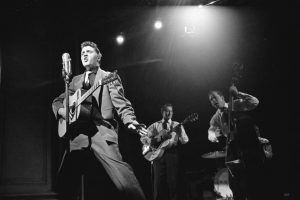
Many of Presley’s Sun recordings are in twelve-bar blues form, but the tempos are almost always faster than those of blues or rhythm and blues recordings. This high level of energy is characteristic of rockabilly. Two examples from Presley’s early recordings at Sun Records are below. The first, “That’s Alright Mama” is a rhythm and blues cover by musician Arthur Crudup and the second is a country/bluegrass song called “Blue Moon of Kentucky by Bill Monroe. Presley and company interpret both songs in the rockabilly fashion.
Elvis Presley and RCA
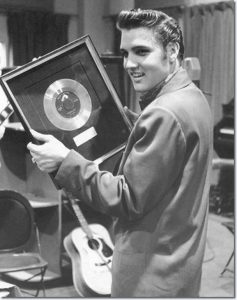
Elvis left Sun records in 1955 when RCA bought his contract for $35,000. RCA offered a more polished sound and much greater publicity. Sam Phillips was upset to see Presley leave his record label, but he felt that rising Sun Records star Carl Perkins could be an even more popular artist. Within a year at RCA records, Presley was a national star and household name. His new record company brought in professional songwriters (Presley was a stellar performing artist and singer, but only occasionally dabbled in songwriting) and recorded with a clean studio production including doo wop style vocals, Fats Domino-style piano accompaniment, and full size bands.
In 1956 Elvis was brought into the homes of Americans all over the country through Television, which by this time was becoming more important than the radio as the source of home entertainment in America. Through his appearances on TV, Elvis was seen by millions of Americans for the first time. He appeared on the TV programs of Ed Sullivan, Milton Berle, and others which, more than radio or concert performances, brought him fame as the first Rock Star. It was on network television that one could reach, simultaneously, a large portion of the country. The sexually suggestive dancing, the sensuality of the voice, and handsome appearance of Elvis had an immediate effect on the youth in America. As a performer, he was utterly captivating.
His recordings around this time began to fit the clean image for the teenage audience. One blues song that did become a hit for Presley was “Hound Dog”, originally recorded by “Big Mama” Thornton and written by Jerry Leiber, Mike Stoller, and Johnny Otis. Thorton’s version used the term “hound dog” as a reference to a man who cheated on a woman, while Presley’s version took a completely different meaning. In it, he complains about a woman by saying she was of “no more use than a hound dog that was no good at catching rabbits” which suits his tough-guy image.
Lyrics to “Hound Dog” by Elvis Presley
You ain’t nothin’ but a hound dog, Cryin’ all the time
Well, you ain’t never caught a rabbit and you ain’t no friend of mine
Yeah they said you was high-classed, Well, that was just a lie
Well, you ain’t never caught a rabbit and you ain’t no friend of mine
Elvis Presley: Military Service and Movie Stardom
Elvis received a draft notice in 1958 while shooting a movie, King Creole. At, arguably, the height of his popularity he was forced to join the army and attend basic training. Just after beginning basic training, Elvis’ mother passed away. His mother was the closest person to him and he called her death the worst loss of his life. His manager, Colonel Tom Parker, managed Presley’s career while he was away, releasing prerecorded songs so the fans wouldn’t be pressed to find a new star in his absence. From 1958-60, Presley had to put his career on hiatus.
Before leaving for basic training, Presley had begun starring in feature films, becoming a movie star in 1956 with the release of Love Me Tender. He would release many more, and with each movie came a stream of hit songs. In 1957 the movies Loving You and Jailhouse Rock featured more hits including “Teddy Bear” and “Jailhouse Rock”.
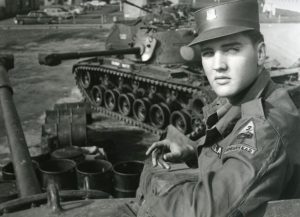
After returning from military service in 1960, Presley, influenced by Parker, focused most of his energy on making movies. Most of his musical output came from these movies. He entered a period of semi-retirement from live performance that would last until his comeback in 1968. With the money he made from film he took care of his parents, buying them both cadillacs. He bought the Graceland estate in 1957.
Elvis Presley: Later Years
In 1968, after years of starring in movies and staying away from live performance, Elvis made a comeback TV special where he performed in an intimate setting with a group of friends, ushering in a new stage of his career. The “Comeback Special” harkened back to his roots with only a few guitars and simple percussion backing Elvis’ vocals. The special was very popular and Elvis earned praise from fans and critics who had wanted him to focus on music again. From that point on he concentrated on live performance and recording. He continued to release hit singles until the year he died, his newer pop style having a popular appeal. He was able to adapt his music to current trends and often covered songs by younger artists making them into his own inimitable versions.
Presley’s life was difficult for the last few years of his life; his wife Priscilla divorced him, and he spent most of his private time alone as a recluse at Graceland. Presley developed drug habits, made worse by the fact that there were many “hangers-on” that provided Elvis with whatever he wanted so they could take advantage of either his friendship or his money, and this contributed to his death in 1977 at the age of only 42.
Exercises 1 and 2
Please listen to the following podcast features an interview with Elvis’ guitar player Scotty Moore about his early years with Elvis, specifically the evening of their first recording session and DJ Fontana, Elvis’ drummer.
This Western Front PDF contains a short, entertaining article entitle “All My Love, Elvis” regarding Elvis on page 3 of the WWU campus newspaper, the Western Washington Collegian (Now called the ‘Western Front’) from February 8, 1957. Enjoy!
Listening Examples 7.2
- “That’s Alright Mama” (1954)
- “Blue Moon of Kentucky” (1954)
Elvis Presley making his television debut with “Hound Dog”, performed on The Milton Berle Show on June 5th, 1956. “Hound Dog” was No. 1 on the pop charts for 11 weeks and No. 1 on the rhythm & blues charts for 6 weeks. The song was written by the R&B songwriting team of Lieber/Stoller for Big Momma Thornton. Elvis covered the song with a faster, lighter sound and many of the lyrics altered so they made more sense as the song was originally written from a female perspective. Listen to the lyrics and try to determine the song form (see lyrics above). The original version of “Hound Dog” performed by Big Momma Thornton. Recorded August 13, 1952 it predates Elvis’ version by 4 years.
- The original trailer for Jailhouse Rock
- “That’s Alright Mama” 1968
Carl Perkins
Carl Perkins – (1932–1998) was an early rock and roll/rockabilly guitarist and composer. A fan of the blues and rhythm and blues, he patterned his style after the rockabilly stylings of Elvis Presley. Perkins auditioned and was signed to Sun records in 1955. Unlike Elvis, Perkins wrote his own songs. One reason Phillips let Elvis go to RCA was because he felt Perkins could be a bigger star. This ultimately didn’t occur as popular tastes continued to change, and the versatility of Elvis meant he could adapt his talents into a film career as well as continuing to perform his own hits as well as contemporary popular songs. Perkins remained a major influence and successful performer in his own right. Bands such as the Beatles cite Carl Perkins as a key influence and the group even recorded two of Perkins’ songs on the album Beatles for Sale in 1964.
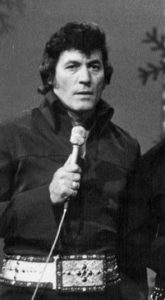
Perkins’ hit “Blue Suede Shoes” was the song that launched his career. Written and recorded in 1955 while rock was just beginning to emerge, the song uses a form of 12-bar blues that extends the first A section using “Stop-Time” where the accompaniment plays brief rhythmic punctuations then the music pauses. This unique and creative approach to 12-bar blues offers for more tension and excitement as most of the popular music at the time was using standard 12-bar form. As in most of the rhythm and blues and rock and roll music, the lyrics use three contrasting lines of text (ABC) rather than using two lines of repeated text and one line of contrasting text (AAB) commonly found in pure 12-bar blues form.
A One for the money (pause) two for the show (pause) three to get ready now go cat go
B But don’t you step on my blue suede shoes
C You can do anything but stay off of my blue suede shoes
Remember, when we take what is essentially 12-bar blues form, but alter the lyrical scheme to three contrasting lines of text, we call this modified 12-bar blues form. When listening to “Blue Suede Shoes” in Ex. 7.3, notice the use of “stop-time” and slapped bass for a rhythmic effect (We can note the influence of Elvis’ bass player Bill Black here.)
Jerry Lee Lewis
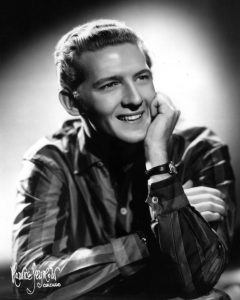
Jerry Lee Lewis – (born 1935) is a pianist and singer who has had an influential career in early rock and roll. He grew up listening to and playing blues, country, and gospel music.
Like Perkins, after hearing Elvis he went to Sun records and signed a contract. At Sun, Lewis covered blues songs first recorded by African American musicians such as “Whole Lotta Shakin Goin On”. Unlike Elvis and Haley, Lewis chose not to clean up the lyrics. Lewis’ signature performing style is one of extreme energy. His right hand flew across the keyboard making use of the glissando (sliding run) and his left hand smashed the keys like a drum keeping time. He often pushed the piano bench away and stood, dancing while playing, and would sometimes play with his feet or jump on top of the piano while singing.
His career took a downturn when it was made public that Lewis had married his 13-year old cousin. This resulted in a boycott of his records and performances. Lewis continued to record with Sun making country music and also continued to perform live, which he continues to this day.
One of Lewis’ most popular songs was “Whole Lotta Shakin’ Going On” written by a songwriter named Dave “Curlee” Williams about whom not much seems to be well-known. When listening below, notice the motoristic boogie-woogie style piano playing as well as the clear accents on the back beat (beats 2 and 4). The song is a standard rhythm and blues number using a modified 12-bar blues form, though the second section shows how similar the first two lines (A & B) are (“Come along baby…”). Again, look at the lyrical scheme of two vocal sections from the song while listening in Ch. 7 Listening Examples:
A Come along my baby, whole lotta shakin’ goin’ on
B Yes, I said come along my baby, baby you can’t go wrong
C We ain’t fakin’, whole lotta shakin’ goin’ on
A Well, I said come along my baby, we got chicken in the barn
B Woo-huh, come along my baby, really got the bull by the horn
C We ain’t fakin’, whole lotta shakin’ goin’ on
Eddie Cochran

Eddie Cochran – (1938–1960) was a rockabilly guitarist, songwriter, and singer as well as actor who continued the rockabilly style, pioneered early rock and roll, and left a lasting influence which is notable for having such a brief career. Cochran’s musical style had lyrics that young people could relate to and the simplicity, catchiness, and power to influence musicians that later played blues, rock, heavy metal, and even punk music. His song “Summertime Blues” became his biggest hit, reaching No. 8 on the Billboard pop charts. Cochran also had success overseas, particularly in England where his single “C’Mon Everybody” charted at No. 6. “C’Mon Everybody” saw Cochran experimenting with the new recording technique called “overdubbing” which he became well known for. Overdubbing allows multiple layers to be recorded over top of one another. In this way Cochran could record multiple instrumental and vocal lines over top of each other by himself. After completing a tour in England with Gene Vincent, Cochran was killed in an automobile accident on the way to the airport at the age of only 21.
Buddy Holly
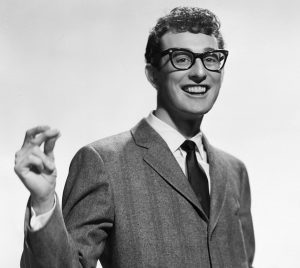
Buddy Holly – (1936–1959) Born Charles Hardin Holley, was a very important innovator in early rock and roll. Holly’s career was cut short by an accidental death at the age of 22. Holly learned fiddle, guitar, banjo, and piano as a child and played bluegrass. He was converted to rock after seeing Elvis perform in 1955.
In 1956, Holly gained a recording contract with Decca records in Nashville playing country music. Unsuccessful, Holly returned to Texas and formed his band, The Crickets, to play rock and roll and recorded their first hit “That’ll Be the Day” in 1957. Holly didn’t have the “dangerous” appeal of Elvis. In fact, he was distinctly different from Elvis; he wrote most of his own music, his vocal style was light, and he used a trademark hiccup on certain parts of the phrase. He wore suits, thick rimmed glasses, and didn’t exemplify a tough guy image.
The Crickets featured the rockabilly instrumentation, but Holly used a solid body Fender Stratocaster. The solid body had a more aggressive, biting tone quality. Drummer Jerry Allison had a much more important role than other rockabilly drummers, including incorporating things like Latin rhythms into the Crickets sound. Their hit “Peggy Sue” (1957) shows their blend of country and blues. The Crickets stayed together until 1958 when Holly left the Crickets to go solo, working on a more pop-oriented style. Holly died in a plane crash while on tour in 1959 that also killed musicians Ritchie Valens and the Big Bopper.
The Solid Body Electric Guitar
The solid body electric guitar possesses quite a different tone quality from acoustic guitars or the hollow body electrics that had been used by guitarists through the 1940’s. Guitarist and inventor Les Paul developed a solid body guitar because he was concerned with the short sustain and feedback problems inherent in hollow body designs. With the solid body, increasing volumes were used and natural amp overdrive would result. The solid body and overdriven tones soon became embraced in rock music. In the late 1950s and early 1960s guitarists such as Buddy Holly began using the solid body, utilizing its more aggressive tone.
Chuck Berry
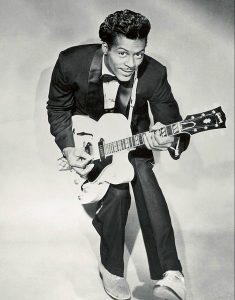
Chuck Berry – (1926–2017) Rock and roll guitarist and singer whose music is rooted in the blues and rhythm and blues. His guitar style and performance style were greatly influenced by T-Bone Walker and Muddy Waters while his singing style was influenced by white country and western singers. It was this fusion of the two sounds that makes Berry’s music a pure and excellent example of early rock and roll.
Berry wrote most of his own music, sang and was an excellent lead guitarist. His songs rang true with teens including songs making fun of classical music, songs about fast cars, laments about school, and others. Berry’s performances were extremely energetic with dance moves like the “Duckwalk”, and his guitar solos would become influential on the course of rock music.
The Everly Brothers

The Everly Brothers were a country influenced rock group made up of brothers Don and Phil, the sons of country musicians. Their music is characterized by closely harmonized tenor voices accompanied by their own rhythm guitars, lead guitarist Chet Atkins, piano, bass, and drums. Their sound was much more smooth, less aggressive than standard rockabilly, and their closely harmonized vocal style had an influence on groups like the Beatles. Compare the vocal sound in the song “All I Have to Do is Dream” by the Everly Brothers and “All My Loving” by the Beatles for example, to see how this influential vocal sound transfers.
Little Richard
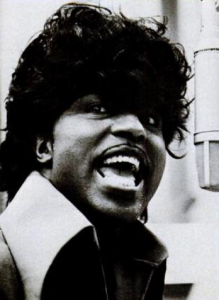
Little Richard – (Born in 1932 as Richard Penniman) is an important rock and roll singer/pianist. He learned to play piano in church where he also learned to sing using gospel characteristics like vocal slides and embellishments.
Richard wrote many of his own songs, sang and played piano on his own recordings. His hits include “Tutti-Frutti”, “Long Tall Sally”, and “Good Golly Miss Molly”. Many of these early songs had lyrics consisting of veiled or not-so-veiled sexual innuendo. Richard’s piano style was based on the boogie woogie style, with a boogie woogie bass line and chords pounding in the right hand. The fast tempos and aggressive vocals are what set his music apart. Most of his songs deal with sex as the primary topic, and his androgynous looks combined with this were shocking. Artists such as Pat Boone, a teen pop idol, covered “Tutti Frutti” and as Bill Haley and Elvis die earlier, Boone recorded a “Clean version” that compromised the lyrics of the original version. In 1957, Little Richard quit rock and roll to become a preacher.
Listening Examples 7.4
Jerry Lee Lewis:
- “Whole Lotta Shakin'” Live 1957
Eddie Cochran
Buddy Holiday:“Peggy Sue” features a modified 12-bar blues form with country/folk style guitar strumming and unique drumming from Crickets drummer Jerry Allison where, instead of accenting backbeats he energetic drum rolls. Listen for Holly’s trademark ‘hiccups’ throughout.
Chuck Berry:“School Days”, a hit of Berry’s from 1957. Notice what happens every time Berry finishes a vocal line: he plays his guitar in “response” to his voice. This is a textbook example (pun intended) of “Call and response”. The song uses a version of 12-bar blues form. Is it standard 12-bar blues or a modified version of 12-bar blues?
Everly Brothers: Notice the influence of the Everly Brothers in “All My Loving” by the Beatles vocal sound starting at 1:14 into the song “All I Have to Do is Dream”.
Little Richard: Notice the aggressive vocal sound in “Tutti Frutti”. Richard combines aggression with the improvisational, embellished vocal approach of gospel music. His vocal style is reminiscent of Sister Rosetta Tharpe in it’s aggression and it’s gospel roots.
Another example of Little Richard’s music is the song “Lucille” which is a showcase for almost all the musical features we’ve discussed in the last few chapters. The song is dominated by a riff in the saxophones and electric guitar. Richards’ piano style is rooted in Boogie Woogie. The first :56 seconds feature pure 12-bar blues form (AAB Lyrical scheme). At :57, we hear “Stop-time” which turns into a modified 12-bar blues form (ABC lyrical scheme)


